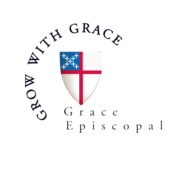
What To Expect
Episcopalians worship in many different styles, ranging from very formal (with vestments and incense) to informal services with contemporary music. Yet all worship in the Episcopal Church is based in the Book of Common Prayer, which makes worship familiar no matter where you go. A Sunday morning service at Grace is characterized by traditional hymns on the organ, ministers wearing vestments, and what we refer to as “Rite II” language (without the “thee” and “thou” of older English).
Episcopal worship is often called “liturgy.” One definition of liturgy is “the work of the people,” reminding us that worship is something a whole congregation takes up together. We stand, we kneel, we sit; we sing, we speak, we listen. The liturgy involves us all, and the liturgy involves all of our selves.
For the first-time visitor, liturgy may be exhilarating or confusing. Please feel free to participate to whatever extent that you feel comfortable. Here’s what to expect.
Readings

We begin by praising God through song and prayer, and then listen to as many as four readings from the Bible – usually one from the Old Testament, one from the Psalms, one from the Epistles, and always a reading from the Gospels. The psalm is usually recited responsively by whole verse.
Sermon
A sermon at Grace allows us to delve more deeply into one or more readings, exploring both the biblical context and how those words from scripture speak to our lives today.

Creed
After the sermon, the congregation recites the Nicene Creed. Written in the 4th Century, it is the Church’s statement of what we believe.

Prayers of the People
Next, the congregation prays together – for the Church, the world, and those in need. We pray for the sick and for those who have died, and we thank God for all the good things in our lives.
Confession
The congregation formally confesses our sins before God and one another. This is a corporate statement of what we have done and what we have left undone, followed by a pronouncement of absolution. In pronouncing absolution, the presider assures the congregation that God is always ready to forgive our sins.
Peace
Those present in the congregation then greet one another, usually with a handshake and a message of “Peace” or “Peace be with you.” If you prefer not to shake hands with those around you, flashing a “peace sign” with your hand, a wave, or a gentle bow or other methods of greeting that may be used.
Eucharist
In the Episcopal Church, the entire service is referred to as the Holy Eucharist. The actual taking of bread and wine is the central focus of the service.
The priest stands at the altar, which has been set with a cup of wine and a plate of bread or wafers, and begins the Eucharistic Prayer. The priest blesses the bread and wine, and the congregation recites the Lord’s Prayer. The bread is broken and offered to the congregation, as the “gifts of God for the People of God.”
At Grace Church we invite all who seek a deeper knowledge of God and who are drawn to Jesus Christ to participate in Holy Communion.
To receive communion, follow others to the altar as directed by the ushers and stand in line to receive bread from a minister. Simply hold your open hands out in front of you, one on top of the other. The minister will place a small wafer in your hand and say, “The Body of Christ, the bread of heaven.” You may eat the bread at that time or hold it until you receive the wine. Of note, if you prefer a gluten-free wafer, please let the minister know as you step forward to receive the bread.
After receiving the bread, you may step over to one of the ministers holding a chalice of wine who will then say to you, “The Blood of Christ, the cup of salvation.” You may either drink directly from the chalce or, if you saved your bread, simply dip it into the wine and consume both together. When you have received both bread and wine, you can stand and return to your seat.
Visitors who do not wish to receive communion may still come forward during the Communion to receive a blessing from the priest. If you wish to receive a blessing, instead of holding your hands out to receive the bread, simply cross your arms over your chest. The priest will take it from there.

Dismissal
At the end of the Eucharist, the congregation prays once more in thanksgiving, and then is dismissed to continue the life of service to God and to the world.
